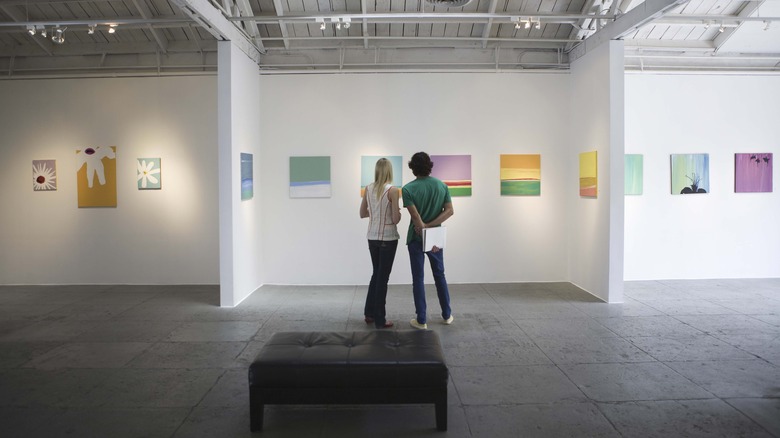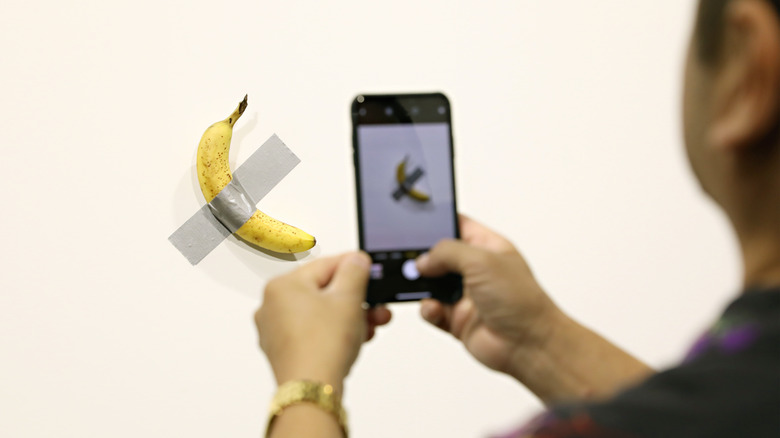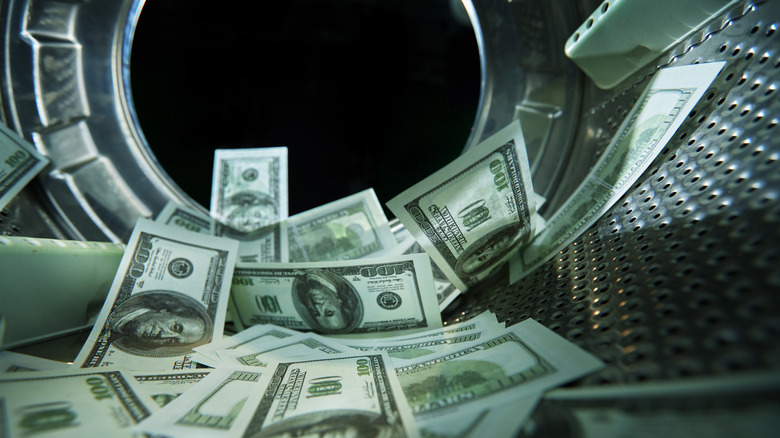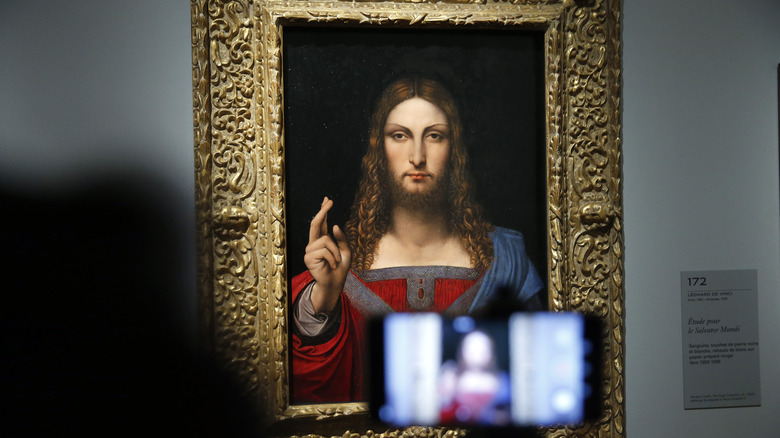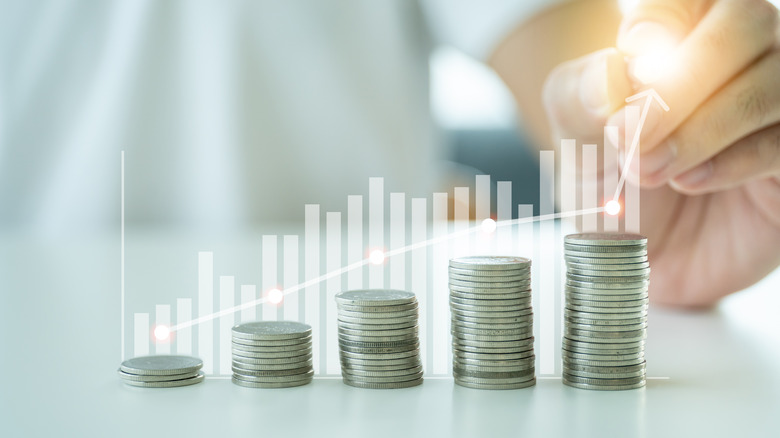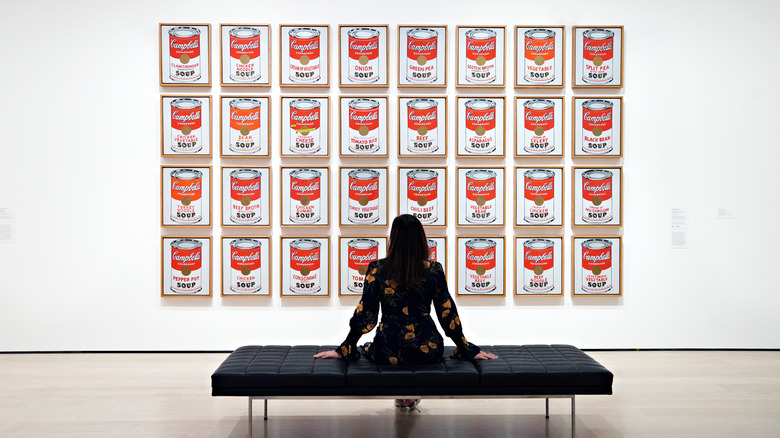Why The Price Of Art Can Be So Controversial
High-profile art auctions regularly fill people with disgust. The astronomical price of art is a controversial topic for many — and in some cases, people have good reason to be enraged. Art valuation is complicated and subject to the whims of fashion (via Artnet). If a famous curator decides to run an exhibition for a particular artist, the price of those paintings will often soar. But the subjective nature of art can make this whole process seem completely arbitrary — and worse, hopelessly elitist. A glance at the Saatchi Gallery's artists to collect in 2022, for example, will introduce you to some talented painters you've probably never heard of. But what, you may wonder separates them from the penniless local artists who work in your hometown? Even art that has obvious historic significance seems ridiculously overpriced — such as Da Vinci's famous "Salvator Mundi", which sold for $450 million in 2017, the most expensive painting to date (via the BBC).
Why is art so expensive, and why does it generate such controversy? Some say the art world belongs to a small clique of ultra-rich snobs — while others argue there are dark forces at work behind the art market. They aren't entirely wrong.
A question of taste?
Some of the rage against the art world today simply has to do with taste. Paintings by the Old Masters are some of the most expensive on the market today (via Christie's). But very old paintings generally generate less outrage than more modern works (via YouGov). From the 19th century onwards, many artists began to step away from realistic styles of painting. This was partly due to the rise of photography — the need to create hyper-realistic paintings just wasn't there anymore (via Business Insider). But when paintings aim to be more realistic or at least require a high degree of technical skill, it's easier for people to understand why they are so expensive.
In order to understand why a conceptual or abstract piece is clever, it often seems like you need a degree in art history. And if a work of art needs some sort of explanation, you could argue that it fails to provide viewers with a meaningful aesthetic experience. On the other hand, even if you "get it," it can often seem that there is nothing to get. Elsewhere, some very expensive pieces appear to be nothing more than a failed attempt at wit — such as the infamous banana taped to a wall that sold for $120,000 (via GQ). Not many people found the knowingly ironic explanation of the work — a clear throwback to Marcel Duchamp's urinal piece, "Fountain" — sufficient to justify the price (via The National).
Money laundering
Even if a person likes contemporary art, the sheer amount of money flowing through the art market may make them feel uncomfortable. Although it sounds like a conspiracy theory, it is true that art is sometimes used for money laundering. A recent crackdown on a drug den in Philadelphia, for example, produced a veritable treasure trove that included works from Pierre-Auguste Renoir and Salvador Dalí (via The New York Times). Until very recently, the sale of art was not subject to much regulation, and it came with a notoriously light paper trail that was hard to trace. In 2020, Britain changed the rules so that the identities of both the buyers and sellers of expensive artworks have to be recorded (via The New York Times).
The anonymity provided by the art market has been a huge boon to criminals looking to hide ill-gotten gains. According to the IMF, a U.S. investigation in 2017 discovered that a securities company had used a Picasso to launder illegal funds — the dirty money was simply tacked onto the price of the painting. The completely arbitrary price tag attached to paintings makes them ideal for handing over large wads of cash — no questions asked.
Oligarchs and princes
Concerns about the art of art-washing go far beyond petty drug dealers — art-based laundering is international in scope. The 2022 crack-down on Russia in the wake of the Ukraine war led to a sudden surge of Western concern over the dark dealings of the art world — and U.S. Congress has launched a probe to investigate how Russian oligarchs may use art to skirt sanctions (via Politico). Many of President Vladimir Putin's nearest and dearest just so happen to be museum board members (via Jacobin), and Russian billionaires are so tied up in the art world that some experts are concerned the collapse of Russian art money will topple whole art galleries and auction houses (via The Guardian).
While cases like this have shaken people's confidence in the legitimacy of art sales, many people have also begun to raise eyebrows at the sale of the $450 million "Salvator Mundi" (per Vox). The buyer, Prince Mohammed bin Salman, de facto ruler of Saudi Arabia, has also been accused of money laundering by conspiracy theorists. The accusation is the result of the ludicrous price tag, as well as doubts over the painting's actual whereabouts and widespread disbelief that Salman makes an unconvincing art aficionado. As of yet, however, there is no proof of foul play, and critics of the theory claim that the painting is safely stored in a Geneva warehouse — and that some very rich people grossly overpay for things (via Artnet).
Greed
True art lovers are often as disturbed by the state of the art market as anyone. Many buyers of expensive paintings appear to view art as an investment and have no interest in the arts at all. A lot of very expensive paintings are not hung on anyone's wall — but are instead tucked away in a warehouse somewhere (via The Economist). The famous Geneva Free Port warehouse in Switzerland, for example, claims to have millions of artworks in its possession (via the BBC). This is particularly sad when you consider these pieces might otherwise hang in a museum.
The enormous sums paid for fashionable artworks often never make it to the artist either — paintings are routinely held and resold by buyers at the right moment, allowing the seller alone to benefit from fluctuations in the market (via Vox). According to The New York Times, artists themselves often do not benefit from these speculative spikes.
How is art even valued?
When all is said and done, however, there are some legitimately good reasons why a piece of artwork may be obscenely expensive. For one, an artist's works are (usually) unique — and scarcity drives value (via Vox). The ultimate source of scarcity is, of course, the death of said artist. Leonardo da Vinci's paintings are among the most expensive, partially because he only painted around 24 in his lifetime (per The National), and fewer than 20 are even known to exist (via Reuters). The number of possible wealthy buyers in the world has also greatly expanded with the growing wealth of emerging economies like China and India (via the BBC). This increased competition has quite understandably flooded the market with cash.
Finally, very costly works have often had a big impact on art history itself. In many cases, a highly valued artist may have pioneered a technique or style that changed the way people paint or draw (via Artnet). Sometimes a famous artwork simply has something interesting to say about the world, such as Andy Warhol's consumerist soup cans or Pablo Picasso's anti-war "Guernica" — images that continue to resonate with us today.
